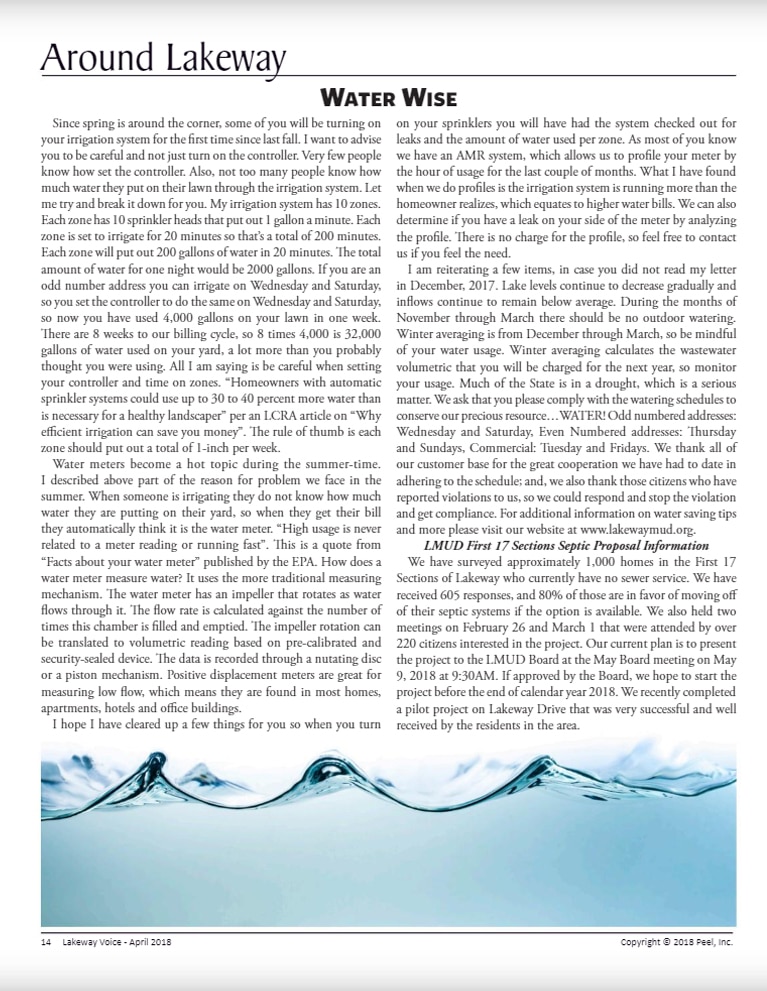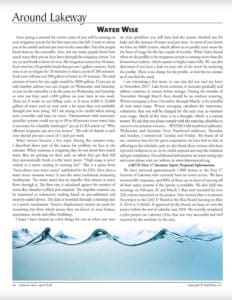Irrigation Systems and Water Meters

As published in Lakeway Voice, April 2018.
Water Wise
Since spring is around the corner, some of you will be turning on your irrigation system for the first time since last fall. I want to advise you to be careful and not just turn on the controller. Very few people know how set the controller. Also, not too many people know how much water they put on their lawn through the irrigation system. Let me try and break it down for you. My irrigation system has 10 zones. Each zone has 10 sprinkler heads that put out 1 gallon a minute. Each zone is set to irrigate for 20 minutes so that’s a total of 200 minutes. Each zone will put out 200 gallons of water in 20 minutes. The total amount of water for one night would be 2000 gallons. If you are an odd number address you can irrigate on Wednesday and Saturday, so you set the controller to do the same on Wednesday and Saturday, so now you have used 4,000 gallons on your lawn in one week. There are 8 weeks to our billing cycle, so 8 times 4,000 is 32,000 gallons of water used on your yard, a lot more than you probably thought you were using. All I am saying is be careful when setting your controller and time on zones. “Homeowners with automatic sprinkler systems could use up to 30 to 40 percent more water than is necessary for a healthy landscaper” per an LCRA article on “Why efficient irrigation can save you money”. The rule of thumb is each zone should put out a total of 1-inch per week.
Water meters become a hot topic during the summer-time. I described above part of the reason for problem we face in the summer. When someone is irrigating they do not know how much water they are putting on their yard, so when they get their bill they automatically think it is the water meter. “High usage is never related to a meter reading or running fast”. This is a quote from “Facts about your water meter” published by the EPA. How does a water meter measure water? It uses the more traditional measuring mechanism. The water meter has an impeller that rotates as water flows through it. The flow rate is calculated against the number of times this chamber is filled and emptied. The impeller rotation can be translated to volumetric reading based on pre-calibrated and security-sealed device. The data is recorded through a nutating disc or a piston mechanism. Positive displacement meters are great for measuring low flow, which means they are found in most homes, apartments, hotels and office buildings.
I hope I have cleared up a few things for you so when you turn on your sprinklers you will have had the system checked out for leaks and the amount of water used per zone. As most of you know we have an AMR system, which allows us to profile your meter by the hour of usage for the last couple of months. What I have found when we do profiles is the irrigation system is running more than the homeowner realizes, which equates to higher water bills. We can also determine if you have a leak on your side of the meter by analyzing the profile. There is no charge for the profile, so feel free to contact us if you feel the need.
I am reiterating a few items, in case you did not read my letter in December, 2017. Lake levels continue to decrease gradually and inflows continue to remain below average. During the months of November through March there should be no outdoor watering. Winter averaging is from December through March, so be mindful of your water usage. Winter averaging calculates the wastewater volumetric that you will be charged for the next year, so monitor your usage. Much of the State is in a drought, which is a serious matter. We ask that you please comply with the watering schedules to conserve our precious resource…WATER! Odd numbered addresses: Wednesday and Saturday, Even Numbered addresses: Thursday and Sundays, Commercial: Tuesday and Fridays. We thank all of our customer base for the great cooperation we have had to date in adhering to the schedule; and, we also thank those citizens who have reported violations to us, so we could respond and stop the violation and get compliance. For additional information on water saving tips and more please visit our website at wordpress-179349-674551.cloudwaysapps.com.
LMUD First 17 Sections Septic Proposal Information
We have surveyed approximately 1,000 homes in the First 17 Sections of Lakeway who currently have no sewer service. We have received 605 responses, and 80% of those are in favor of moving off of their septic systems if the option is available. We also held two meetings on February 26 and March 1 that were attended by over 220 citizens interested in the project. Our current plan is to present the project to the LMUD Board at the May Board meeting on May 9, 2018 at 9:30AM. If approved by the Board, we hope to start the project before the end of calendar year 2018. We recently completed a pilot project on Lakeway Drive that was very successful and well received by the residents in the area.



 You are now being redirected to the WaterSmart page.
You are now being redirected to the WaterSmart page.